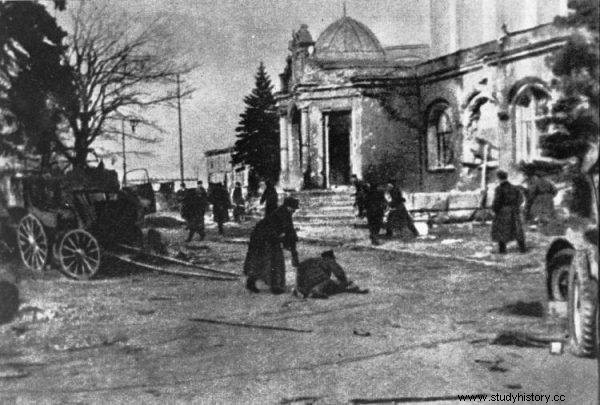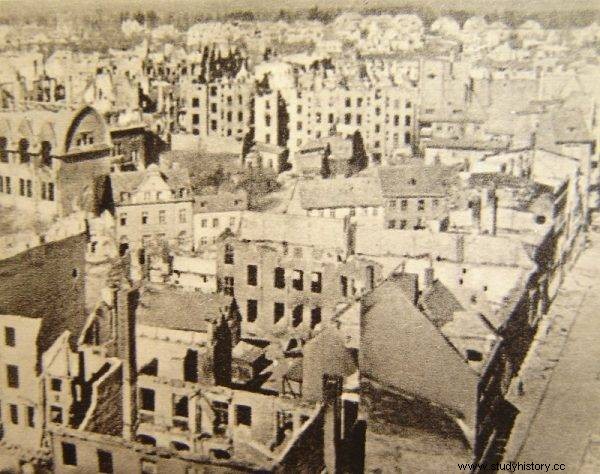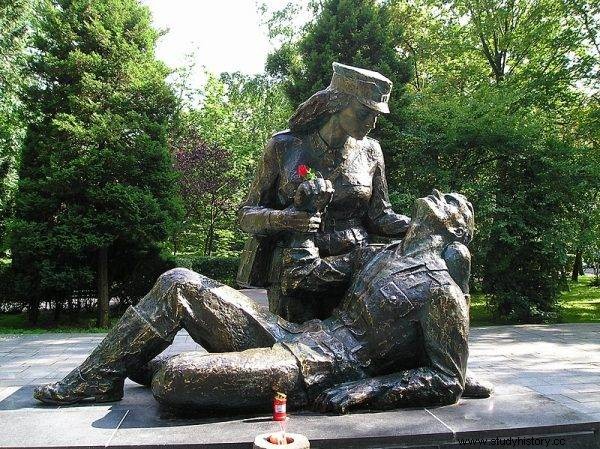The Nurse Monument shows a girl in a uniform tending a soldier. Its prototype was to be "Linka", who died in the bloody fights for Kołobrzeg.
In Kołobrzeg, there is a monument to a woman whose face is never illuminated by the sun. Unique monument. The only one in Poland and Europe. Dedicated to all nurses helping the wounded on the battlefields of World War II.
Monument hero
March was another anniversary of the fighting for Kołobrzeg. Therefore, it is worth remembering the girl from the monument who died in 1945. The fights for Kołobrzeg took place from March 4 to 18, 1945 . There was no indication that they would be so bloody. The German situation in Pomerania was dramatic, Hitler was foaming. He ordered the armlets of his select troops to be torn off, demoted officers, handed down death sentences "right and left".

Fighting for Kołobrzeg in 1945
Contrary to common sense, against the sober opinions of his staff, Hitler announced Kołobrzeg as a fortress in November 1944. In March 1945, nothing changed in this regard. Kołobrzeg was to defend himself to the last soldier . Goebbels developed an extensive propaganda campaign. He called for defense. It was reminiscent of 1807, when Kołobrzeg, besieged by Napoleon's army, defended itself successfully for a long time. The first, unsuccessful attack on Kołobrzeg was launched by the Red Army. In the following days, the 6th Pomeranian Infantry Division entered the fight. It was in this Division that our heroine from the monument, Ewelina Nowak, served.
"Link"
"Linka" - that was what her relatives called her - was a full of life, cheerful girl from Mirosławka near Łuck in Volhynia. She was a terrible mischief, so her friends called her "Hansel" . Even at the front, she was joking. On night watch, she would wake the cooks at three in the morning and tell them it was breakfast time. The same troublemaker was distinguished by incredible calmness, determination and courage during the fights.
She was born on July 30, 1925. During most of the occupation, she worked on her parents' farm. That changed in the summer of 1944. Then, together with her cousin, she was mobilized to the 1st Polish Army. She was trained in the communications company of the 14th infantry regiment. Then she took a sanitary course in the 4th Infantry Division.

Destroyed buildings in Kołobrzeg
She was a nurse in the 14th Kołobrzeg Infantry Regiment (6th Pomeranian Infantry Division). When the fighting for Kołobrzeg began in 1945, she was only 20 years old. Before she joined Festung Kolberg, it participated in the January offensive of 1945 (the Vistula-Oder operation) and in the fights for Warsaw on January 16-17. She took part in breaking the Pomeranian Wall near Nadarzyce, Iłowiec and Wierzchowo. Anyway, then she was awarded the silver medal "Zasłużony na Polu Glałów".
Festung Kolberg
From the first days of March, she participated in heavy fights for Kołobrzeg. On March 10, incredibly tired, she goes under fire for the last time to pick up the wounded. He wouldn't be able to help him anymore. The bullet of a sharpshooter hits her. Only under the cover of night can her friends reach her. They're carrying her body on a stick.
During the fighting, there was neither time nor possibility to organize a funeral. They were buried in mass graves, but more often funerals were held only after the end of the fighting. In Kołobrzeg, no one had the head for such ceremonies. Immediately after capturing the city, the army had to move on to Berlin . Only the first settlers dealt with burial. However, an exception was made for our nurse. Colleagues demanded a burial for her with all military honors . The command agreed to that. She was buried on March 15, 1945 near the place where she died. Posthumously, she was promoted to the rank of bombardier.

The Paramedic Monument in Kołobrzeg
After 14 days of heavy fighting, Kołobrzeg was finally conquered. On the night of March 17/18, after the regrouping of troops and strong artillery preparation (artillery, mortars and Soviet "Katyushas"), began the general assault of the third defense ring . In the morning, the railway station and port were captured. Not all of the Germans managed to evacuate. Most died or were taken prisoner. In addition to the fights in Warsaw in 1939, the Warsaw Uprising and the storming of Berlin, in the fights for Kołobrzeg, Polish soldiers fought the greatest street fight during World War II . Despite the fact that contemporary historians argue fiercely whether to celebrate the capture of these lands and call it liberation or not, the Poles played a decisive role in the battle for Kołobrzeg and entered the history of the Polish army for good.
The Paramedic Monument
After the war Ewelina Nowak's body was moved to the War Cemetery in Kołobrzeg - Zieleniewo . On July 13, 1980, Lieutenant General Józef Urbanowicz (also a participant in the fights for Kołobrzeg) unveiled the Paramedic Monument, which depicts a kneeling girl in a uniform dressing up a wounded soldier. The prototype of the monument was to be Ewelina Nowak. Ultimately, however, Wrocław sculptor Adolf Cogiel chose Zofia Jankowska, who had been accidentally spotted on Wrocław street, as a model. The photo "Links" can be seen at the Museum of Polish Arms in Kołobrzeg.
